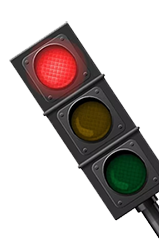


These signs are used to control the actions of drivers and regulate the flow of traffic.

Stop Line:
Stop completely before the solid stop line. Move off only when safe to do so.

Yield line:
Slow down and give way to traffic and pedestrians crossing or waiting to cross your path. Applies also at railway crossing.

Pedestrain crossing:
Give way to any pedestrians on or about to enter the pedestrian crossing on your side of the road from either side.
.gif)
Block pedestrian crossing:
Give way to any pedestrians on or about to enter the pedestrian crossing on your side of the road from either side.

No overtaking line:
(on its own or on your side of a broken divided line). You may not allow any part of the vehicle to cross the line, except to access property on the other side, or to avoid a stationary obstruction.

No crossing double line:
You may not allow any part of the vehicle to cross the line at any time. The two solid lines sometimes have a broken divided line between them.

Channelizing line between lanes of traffic moving in the same direction:
You may not allow any part of the vehicle to cross the line at any time.

Yellow left edge marking:
You may not drive to the left of the yellow line, except when permitted to allow another vehicle to overtake (see rules of the road).

White right edge marking:
You may not drive or cross to the right of the white line. U-turns are NOT PERMITTED on freeways over the white edge line.

Painted island:
You may not drive or stop over the marking.

Parking bay:
Park only in the demarcated area and not on any sidewalk or verge.
Ambulances
Buses
Taxis
Firefighting
Diplomatic vehicles
Mini buses
Defense force
Police
SOS telephone: in an emergency only
Rickshaws
Loading zone

Exclusive parking bay:
The parking bay is reserved for the exclusive use of the kind of vehicle indicated by the accompanying symbol, in this case goods vehicles.

Exclusive parking bay:
For vehicles carrying disabled persons.

Mandatory direction arrows:
Various examples.

Lane reserved for buses only:
No other vehicle type may drive, stop or park in this lane.

Lane reserved for trams only:
No other vehicle type may drive, stop or park in this lane.

Lane reserved for hazardous goods vehicles only:
No other vehicle type may drive, stop or park in this lane.

Lane reserved for bicycles only:
No other vehicle type may drive, stop or park in this lane.

Box junction:
You may not stop on this painted marking unless you are entering the road from the side to turn left or right.

No stopping solid red line:
You may not stop on or next to this red line at any time.

No stopping broken red line:
You may not stop here during the time/s indicated on the accompanying road sign.

No parking solid yellow line:
You may not park on or next to this yellow line at any time.

No parking broken yellow line:
You may not park here during the time/s indicated on the accompanying road sign.

No motorcycles:
Motorcycles may not proceed beyond this marking.

Mini circle:
Travel in a clockwise direction and give way to any vehicle that will cross a yield line before you and is likely to cross your path.

Disabled persons parking:
The parking bay is reserved for a vehicle carrying a disabled person. No other vehicle may park here.

Exclusive use lane symbol:
Only cyclists may use this lane.

Exclusive use lane symbol:
Only buses may use this lane.

Exclusive use lane symbol:
Only trams may use this lane.

Exclusive use lane symbol:
Only vehicles transporting disabled persons may use this lane.

Exclusive use lane symbol:
Only high-occupancy vehicles may use this lane.
These signs are used to control the actions of drivers and regulate the flow of traffic.

Railway crossing ahead

Continuity line:
The roadway to the left of the thick marking discontinues straight ahead, the gaps become progressively shorter as the line continues.

Lane line:
Short, thin lines to separate lanes of traffic moving in the same direction, the gaps may be longer or shorter.

Dividing line:
Longer, thinner lines to warm that vehicles on the other side of the line are travelling towards you; the gaps may be shorter or longer.

Reversible lane double lines:
Warns that the lane with the double-arrow is used by oncoming traffic during specified periods.

Mandatory direction arrows ahead:
Warns that there are yellow mandatory direction arrows ahead.

No overtaking or crossing line ahead:
Warns that you are not permitted to cross the solid line ahead. Do not attempt to overtake at this point.

End of exclusive use lane:
Warns that the exclusive use lane ends here.

End of exclusive use lane:
Warns that the exclusive use lane ends here.

Furcation arrows:
There is an increase in the number of lanes ahead, in the direction/s indicated by the arrows.

Direction of travel indicators:
Indicate the direction in which vehicles may travel.

Cycle crossing:
Cyclist across the road at the place indicated by the broken lines.

Yield ahead:
Warns that there is a regulatory yield sign or marking ahead.

Arrestor bed ahead:
For emergency stopping.

Escape road ahead:
For emergency purpose.

Speed hump:
Reduce speed.

Kerbing:
To indicate the presence of a raised sidewalk or island kerbing.

Gives extra guidance:
To road users in respect of cyclists.

Gives extra guidance:
To road users in respect of direction to the airport.

Gives extra guidance:
To road users in respect of the handicapped.

Gives extra guidance:
To road users in respect of high occupancy vehicles.

Gives extra guidance:
To road users in respect of stopping.

Gives extra guidance:
To road users in respect of a school.